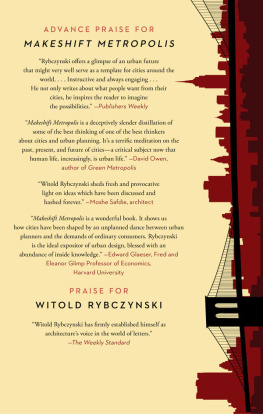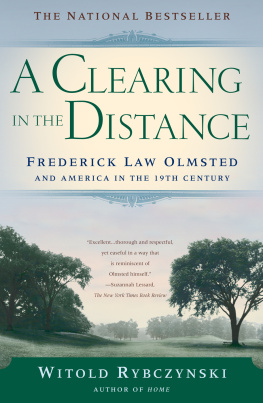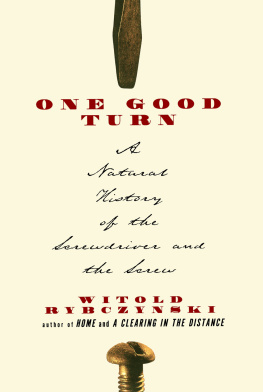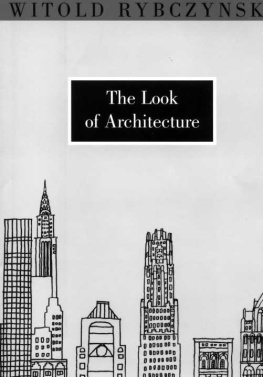Rybczynski - City Life
Here you can read online Rybczynski - City Life full text of the book (entire story) in english for free. Download pdf and epub, get meaning, cover and reviews about this ebook. City: New York;United States, year: 1996, publisher: Scribner;Simon & Schuster, genre: History. Description of the work, (preface) as well as reviews are available. Best literature library LitArk.com created for fans of good reading and offers a wide selection of genres:
Romance novel
Science fiction
Adventure
Detective
Science
History
Home and family
Prose
Art
Politics
Computer
Non-fiction
Religion
Business
Children
Humor
Choose a favorite category and find really read worthwhile books. Enjoy immersion in the world of imagination, feel the emotions of the characters or learn something new for yourself, make an fascinating discovery.

- Book:City Life
- Author:
- Publisher:Scribner;Simon & Schuster
- Genre:
- Year:1996
- City:New York;United States
- Rating:4 / 5
- Favourites:Add to favourites
- Your mark:
- 80
- 1
- 2
- 3
- 4
- 5
City Life: summary, description and annotation
We offer to read an annotation, description, summary or preface (depends on what the author of the book "City Life" wrote himself). If you haven't found the necessary information about the book — write in the comments, we will try to find it.
City Life — read online for free the complete book (whole text) full work
Below is the text of the book, divided by pages. System saving the place of the last page read, allows you to conveniently read the book "City Life" online for free, without having to search again every time where you left off. Put a bookmark, and you can go to the page where you finished reading at any time.
Font size:
Interval:
Bookmark:
Thank you for downloading this Scribner eBook.
Join our mailing list and get updates on new releases, deals, bonus content and other great books from Scribner and Simon & Schuster.
C LICK H ERE T O S IGN U P
or visit us online to sign up at
eBookNews.SimonandSchuster.com
We hope you enjoyed reading this Scribner eBook.
Join our mailing list and get updates on new releases, deals, bonus content and other great books from Scribner and Simon & Schuster.
C LICK H ERE T O S IGN U P
or visit us online to sign up at
eBookNews.SimonandSchuster.com
OTHER BOOKS BY W ITOLD R YBCZYNSKI
Paper Heroes
Taming the Tiger
Home
The Most Beautiful House in the World
Waiting for the Weekend
Looking Around
A Place for Art

T OUCHSTONE
Rockefeller Center
1230 Avenue of the Americas
New York, NY 10020
www.SimonandSchuster.com
Copyright 1995 by Witold Rybczynski
All rights reserved, including the right of reproduction in whole or in part in any form.
First Touchstone Edition 1996
T OUCHSTONE and colophon are trademarks of Simon & Schuster Inc.
The Library of Congress has cataloged the Scribner edition as follows:
Rybczynski, Witold.
City life: urban expectations in a new world / Witold Rybczynski.
p. cm.
Includes index.
1. Cities and townsUnited StatesHistory.
2. City planningUnited States.
3. Architecture and societyUnited States.
I. Title.
NA910S.R93 1995
711'.4'0973dc20
95-12648
CIP
ISBN-13: 978-0-684-81302-8
ISBN-1O: 0-684-81302-5
ISBN-13: 978-0-684-82529-8 (Pbk)
ISBN-10: 0-684-82529-5 (Pbk)
ISBN-13: 978-1-476-73734-8 (eBook)
To Shirley, Stacy, and Nan
Oft expectation fails, and most oft there Where most it promises
W ILLIAM S HAKESPEARE
W hen I was twenty-two, I made an urban tour. It was thanks to a traveling scholarship awarded by the Canadian federal government to one student from each of the countrys six schools of architecture. Together we visited more than a dozen major cities in Canada and the United States. It was a memorable trip, not just because I made a lifelong friendthe Vancouver architect Bing Thombut also because I was encouraged to look more closely at my urban surroundings.
The stated purpose of the scholarship was to study housing, and we visited an apartment building on Philadelphias Ritten-house Square, suburban houses in Marin County, public housing in Toronto and Chicago, and renovated slums in Baltimore. It made me appreciate the richnessand the complexityof North American cities. The previous summer I had been to Europe. I had been impressed by Rome, London, and Parisespecially Parisbut it was obvious that our cities were different from what I had seen there. If European cities seemed like beautiful architectural museums, our cities were more like unfinished building sites where each generation was free to try its hand.
We were eager to have our turn. I think the first book I read on urban planning was Victor Gruens The Heart of Our Cities. I dont remember exactly what it was that prompted me to buy itit wasnt a course text. The authors suggestion that downtown should be redesigned must have been appealing to a budding architect like me. I was probably also attracted by the dramatic combination of alarm and resolve in the subtitle: The Urban Crisis: Diagnosis and Cure.
In what follows I am more interested in looking at how our cities have become the way they areor, more precisely, have not become what we expected them to bethan in looking for crises or imagining diagnoses and cures. This is a book about cities as they are, not as they might be. It is also about cities evolution, for Im convinced that our undistinguished record of the last fifty years in building cities and towns stems at least in part from a willful ignorance of our urban past. At the same time, this record is also the result of our inability to anticipate the new technological and social forces that came to bear on our urban condition: the automobile, air travel, electronic communications. There is no such thing as perfect foresight, of course, so we can never plan infallibly, but we can face the urban future with modesty and an approach tempered by a knowledge of earlier successes and failures. In order to understand where were going, its necessary to know where weve been.
The opportunity to write about urbanism was presented to me first by a number of editors whose encouragement I would like to acknowledge: William Whitworth of The Atlantic Monthly (in which a part of Chapter 9 originally appeared as an article); the helpful Robert Silvers of The New York Review of Books; The Public Interests Nathan Glazer, whose urban writings I have always admired; and Marilyn Minden of The New York Times. Some of the ideas in this book were initially explored in articles and reviews in City Journal , the Times Literary Supplement, Queens Quarterly, and Saturday Night. Paula Deitz and Susan Cohens kind invitation to speak at a Smith College symposium spurred me to reflect on the design of New England towns. Jerry Herron of Wayne State University invited me to Detroit to participate in a panel on The City in the Twenty-first Century that gave me useful firsthand experience of the volatile state of American urban politics.
The University of Pennsylvania has proved a congenial academic setting for pursuing my interest in urbanism; my thanks to Dean Patricia Conway of the Graduate School of Fine Arts and to Peter D. Linneman of the Wharton School. I would also be remiss in not acknowledging the support of two eminent urban scholars, Martin and Margy Meyerson, for whom the university chair I hold is named.
Shirley Hallam is my first and truest reader, and she has offered equal doses of skepticism and encouragement at the appropriate times. John Lukacsnow a neighborkindly reviewed my work, and his thoughtful observations were much appreciated. Stacy Schiff took time away from her own writing to cast a seasoned editors eye on the manuscript. Carl Brandt, agent and friend, helped me to clarify my ideas when the book was still a vague intuition; he was a sympathetic sounding board throughout. Thanks to Iris Tupholme of Harper-Collins in Toronto. At Scribner, the energetic Nan Graham provided sterling editorial advice and support, and got me out of a few dead ends; Nancy Inglis did a fine job of copy editing.
W.R.
Hemmingford, September 1992
Philadelphia, January 1995.
I VISITED PARIS IN THE fall of 1992, After An Absence of more than fifteen years. People had changed, of course. There were more nonwhite faces on the Mtro, and, generally, many of the faces seemed less cheerful, or was that just my imagination? The subway cars themselves were much the same, with the flip-down seats near the doors, and places reserved for the elderly and for crippled war veteransa grisly reminder of the 1914-18 conflict. There were no survivors of the Great War in evidence, but I didnt even see many people who looked, well, French. No elderly gentlemen wearing pale leather gloves and rosettes in their lapels, for example. No businessmen with those curious suits with short, ventless jackets and wide shoulders that I associated with actor Lino Ventura and French gangster movies. Workers were wearing nylon windbreakers rather than traditional blue overalls. Parisians, who had previously seemed to me, a North American, slightly old-fashioned, with their distinctive customs and elaborate courtesies, now appeared familiar.
Next pageFont size:
Interval:
Bookmark:
Similar books «City Life»
Look at similar books to City Life. We have selected literature similar in name and meaning in the hope of providing readers with more options to find new, interesting, not yet read works.
Discussion, reviews of the book City Life and just readers' own opinions. Leave your comments, write what you think about the work, its meaning or the main characters. Specify what exactly you liked and what you didn't like, and why you think so.




